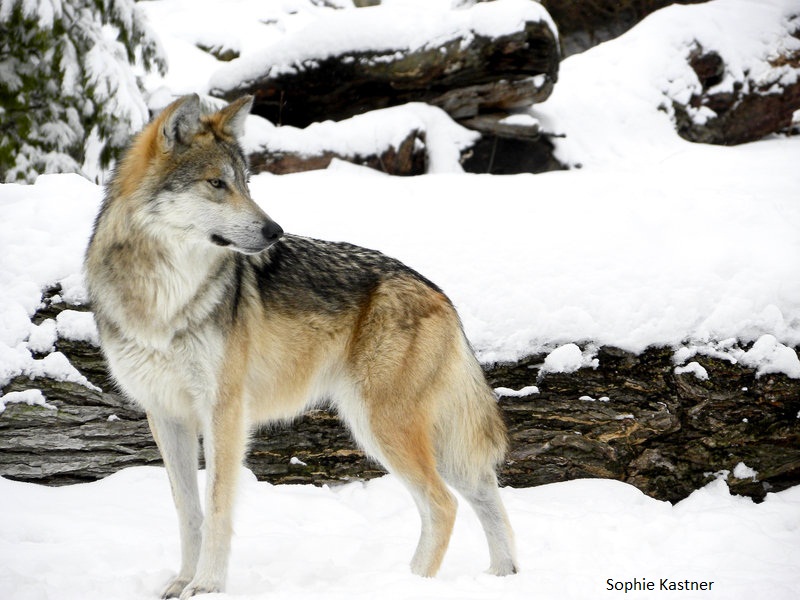28
Feb
In the News: Can Mexican gray wolves coexist with people, cattle? Ranchers, conservationists test the idea

Todd Swinney was tending cattle in the high country near Eagar last spring when he spotted them, a pack of Mexican gray wolves known as the Diamond Pack.
He had been walking for hours in the cold through a pine forest, straining to see through the thickets of trees. He breathed in the smell of soggy pine needles as wind gusts nipped at his face.
The wolves stood and stared at him. They seemed to be stirring from a nap, as Swinney remembers it. The animals had let Swinney get close, within about 40 feet, closer than he cared to be.
Sometimes he could scare wolves away on Call, the horse he named after Captain Woodrow Call, the retired Texas Ranger and fellow cattleman from “Lonesome Dove.” But this time he was on foot.
He jumped up and down, hollered and waved. They weren’t scared. They didn’t understand how dangerous he could be.
Cattlemen and wolves have been at odds for decades, almost from the time they began to share the land. Settlers to the West nearly drove Mexican gray wolves extinct in government-sponsored eradication campaigns intended to benefit livestock herds.
Even now that the wolves are protected under the Endangered Species Act, the old conflict weighs on their fitful recovery.
Authorities may still kill them or remove them from the wild under the law if they prey on livestock because the wolves are deemed a “nonessential experimental population.” Illegal shootings happen every year and those human-caused deaths contribute to wolf advocates’ fear that Mexican gray wolves may never recover.
In the woods that day, Swinney lifted his shotgun, a 12-gauge “beater-upper.”
Researchers from several universities estimated in 2006 that cattle only make up a small fraction of Mexican gray wolves’ diet, but Swinney couldn’t have these wolves near the herd.
Luckily for the Diamond pack, he wasn’t out to kill.
Swinney believes cattleman and wolves can coexist. He uses ranching techniques to reduce conflicts between livestock and wolves, countering two competing undercurrents that wolves are bad for cattle and cattle are bad for wolves.
Swinney monitors wolves with the help of federal and state authorities, while strategizing with wolf advocates to steer them away from cattle.
His role is both the cattle’s guardian and the wolves’ savior, working under a partnership with the conservation group Defenders of Wildlife. It’s one of a growing number of partnerships in the organization’s coexistence program.
Coexistence programs propose to solve a tug of war that has complicated efforts to recover the Mexican gray wolf population and remove it from the endangered species list.
Recovery plan stokes new debate
Last year the U.S. Fish and Wildlife Service issued a long-awaited revised recovery plan that walked a tightrope between many interests.
It considers human-caused deaths a leading threat to Mexican gray wolves. Many of these deaths stem from conflicts between wolves and livestock.
The recovery plan compels states and tribes in the U.S. to implement “regulatory mechanisms” to reduce the number of wolf deaths caused by humans. And it calls on Mexico to do the same.
The plan would delist the wolf when its population in the wild averages 320 in the U.S. and 200 in Mexico when counted over eight years. At least 114 Mexican gray wolves roamed parts of Arizona and New Mexico in 2017, while Mexico had about 31. The U.S. population had grown slightly in recent years, but fewer pups survived in 2017, leaving the overall count almost unchanged from 2016.
A key element of the plan is releasing captive wolves from a binational breeding program into the wild to diversify this species’ genetic makeup. Authorities may also translocate wild wolves to other designated corners of Arizona, New Mexico and Mexico to disperse genetic diversity.
After these wolves are moved or released, the plan requires 22 in the U.S. and 36 in Mexico to survive until breeding age or for a year, depending on their age.
The U.S. Fish and Wildlife Service may also capture wolves from the wild to place in captivity, according to the recovery plan. Many of these removals from the wild are due to conflicts with cattle andthey chip away at population numbers just like deaths.
Environmentalists say the plan imperils the wolves, while many cattlemen say it allows too many.
Environmental groups, including Defenders of Wildlife, have sued the U.S. Fish and Wildlife Service, claiming the plan falls dangerously short of safe population numbers and fails to protect wolves from inbreeding and illegal killings.
Meanwhile, Sen. Jeff Flake, R-Ariz., introduced legislation that would effectively circumvent the plan by lowering the population numbers needed to remove the wolf from the endangered species list.
While politics and lawsuits play out, those who believe in coexistence see it as a way forward on the ground.
This article was published in AZ Central



